#bible analysis
Text
Me hanging out with Jesus because he was actually pretty chill

Me getting into a fist fight with God because that guy was a fucking asshole

#shitpost#religious trauma#religious trauma memes#ex christian#ex evangelical#jesus memes#god memes#fighting god#fuck god#fuck the church#fuck christianity#christianity#anti christian#christian memes#bible analysis#biblical analysis#swearing#tw swearing#cw swearing
165 notes
·
View notes
Text
I think one of the biggest tragedies of Laios & Falin and their relationship is how much his actions impact her life. But like. Specifically how much they WOULDN’T impact her life as much if they weren’t both stuck in such a shitty abusive situation.
This part of the Falin-tries-makeup daydream hour comic is what got me thinking about it again because truly it just... it seems like such a like an offhand comment that I'm sure Laios didn't mean to be cruel or anything. That's just like. A little kid not thinking about what they are saying. ESPECIALLY when the kid in question is Laios.
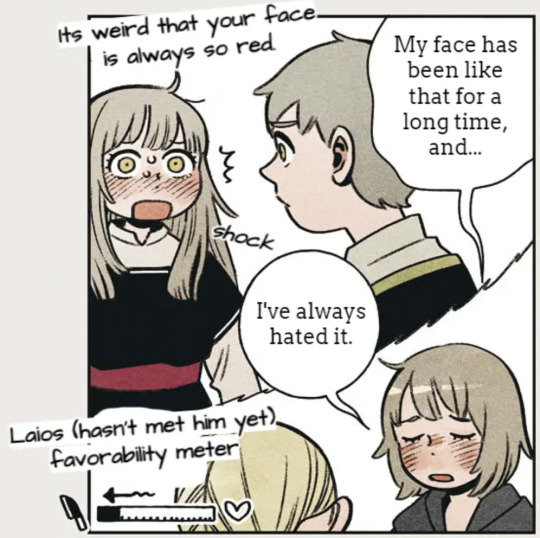
But man they depended on each other SO much as kids. Too much. It really feels like they didn't have any other source of positive reinforcement, or anyone else to share themselves with. So of course an offhand comment like that has a huge impact on Falin.
Or this little bit from one of the flashbacks:
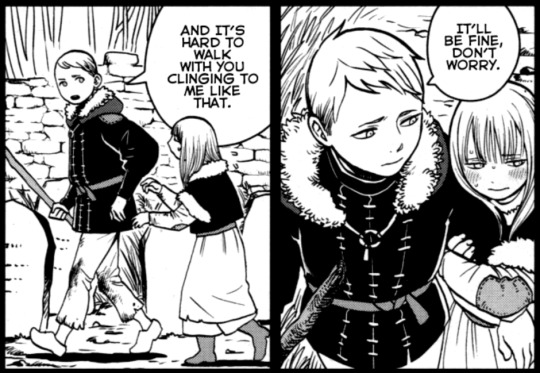
This tears me apart. Do you think it tears him apart to think about? I think it does. I think Laios holds every small failure to care for Falin against himself.
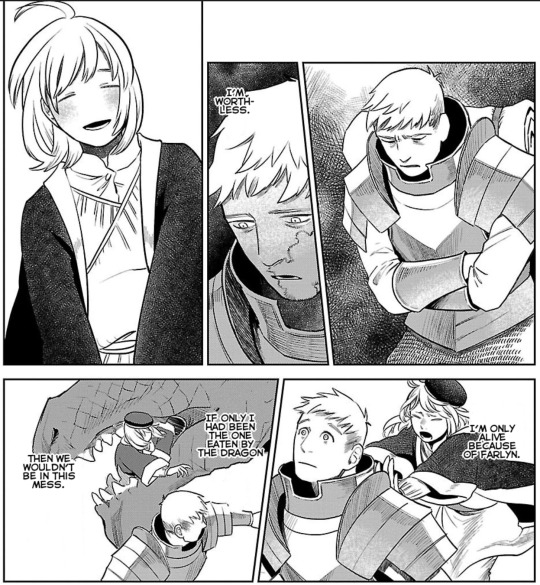
And then there's the Bigger stuff. The way that him coping with his own trauma ended up impacting her.
Like his interest in monsters. Like him going to find a ghost, and accidentally revealing Falin's magic to the whole village in the process.
Like him needing to leave. And leaving her behind.
He shaped her life so much, and he carries so much guilt for it. And again, there should have been other people there to help. The same things that made Laios need to leave home are the things that made his leaving so hard on Falin. She ate alone after that. She shouldn't have had to eat alone just because Laios wasn't there.
She was 9 when he left for school, and he was 11.

Nine. And Laios feels like he failed her because he didn't stand by her through this better. As an eleven year old.
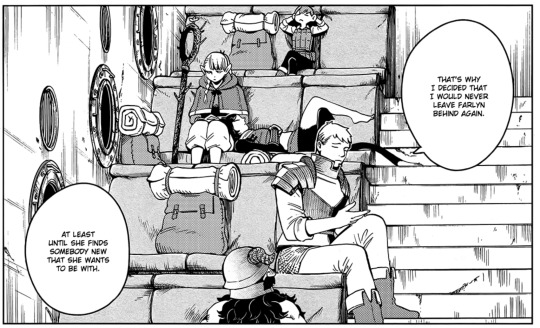
Both of these kids deserved so much better from the world.
#dunmeshi analysis#dungeon meshi#delicious in dungeon#falin touden#laios touden#dungeon meshi spoilers#AND this isn't even getting into her leaving the academy & how much it seems like that was directly tied to how poorly he was doing#there's a comic in the adventurer's bible where marcille is like 'yeah she had a job lined up and everything'#and like. do you think he feels bad for that too#like he wrecked her life by leaving#and wrecked her life by showing up#what do you even do at that point. if you feel like a failed protector when you are away & and a burden when you return#unable to make yourself accept. unable to make yourself resist#Laios strongest moment is when he lets himself accept that. the contradiction of his life & his relationship with Falin#that he has to kill her to save her#as a small note this came out a little more focused on Laios' POV with this stuff but Falin's experience of it is v important to me too#didn't mean to sideline her but her feelings about stuff are more speculative and probably need a post of their own
8K notes
·
View notes
Text
James 2:13 and the Importance of Mercy
I recently had a vivid and, well, frightening dream that led to me looking up this specific Bible verse:
“For judgment is without mercy to one who has shown no mercy. Mercy triumphs over judgment.”
James 2:13
Failing the Mercy Test
In the aforementioned dream, I watched a malicious serial killer enter some sort of supernatural building that had a bizarre elevator. The elevator could apparently…
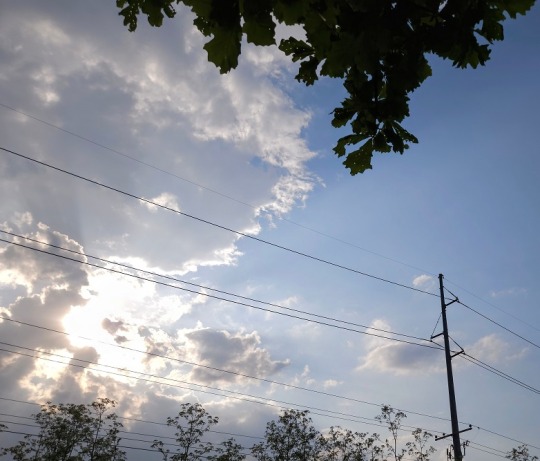
View On WordPress
1 note
·
View note
Text
Ok, so. Heaven.
In the court in ep6, we see 5 different types of angels (on top of the Seraphim).
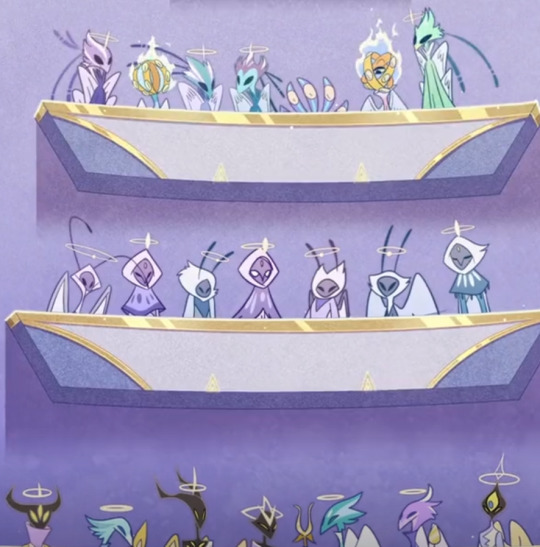
In the middle there are moth/bug-looking ones (mix of antenna/no antenna). Then we've got the birdies (the ones at the top have extra Long Feathers) and the very demonic looking horned ones at the bottom. (And this one guy at the top with the eyed appendages)
On top of those are what I think are Ophanim; wheels with eyes on them at the top. We see them in the beginning narration of ep1,

And it looks like two of the angels we saw creating Earth might also be Ophanim (the 2 lower ones)
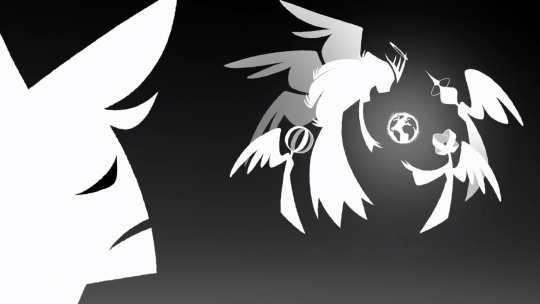
One of these angels was clearly Sera, a Seraph we later see accompanied by Emily. Sera is the "Head Seraph" and expresses that it's her job to take care of things since she's older.
People have theorized that Seniority is an important thing among angels because of that and how, in the ep1 narration, it's said the Elders of Heaven disapproved of Lucifer's ideas for creation.

We are shown 6 angels here (7 including Lucifer), all of them with unique halos (and heads!) making them distinct from each other.
And in ep5, we see the same group of 6 with the exact same halos again
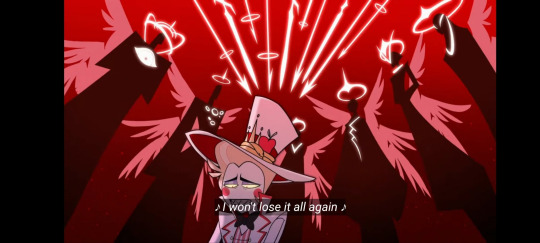
Except this time they're even more distinct, with distinguishing silhouettes&markings added.
Seven angels, including Lucifer? Almost like... the Archangels?
#hazbin hotel#my hazbin posts#hazbin hotel lucifer#hazbin hotel sera#hazbin hotel heaven#hazbin hotel analysis#im just tryna put it all down in an organized way to well. organize my thoughts#also WARNING i dont know much abt christianity and the bible and whatever so. sorry for any inaccuracies there#hazbin hotel theory#hazbin hotel angels#going insane abt heaven I NEED TO KNOW. I NEED TO KNOW. TELL ME WHATS GOING ON UP THERE TELL MEEE
407 notes
·
View notes
Text
“jax is such an asshole he doesn’t care about any of the other characters” ok well you clearly didn’t see how scared he was when he found out kaufmo had abstracted. you obviously didn’t notice the part where he tried to protect kinger and gangle from abstracted kaufmo. you for sure didn’t see the way he uses humor to try to keep the mood light so everyone doesn’t panic.
#none of these words are in the bible#i’m serious though i’m gonna elaborate on this later#tadc#jax#kinger#gangle#kaufmo#tadc analysis
832 notes
·
View notes
Text
World Map Notes: the Elven Northern & Southern Central Continents
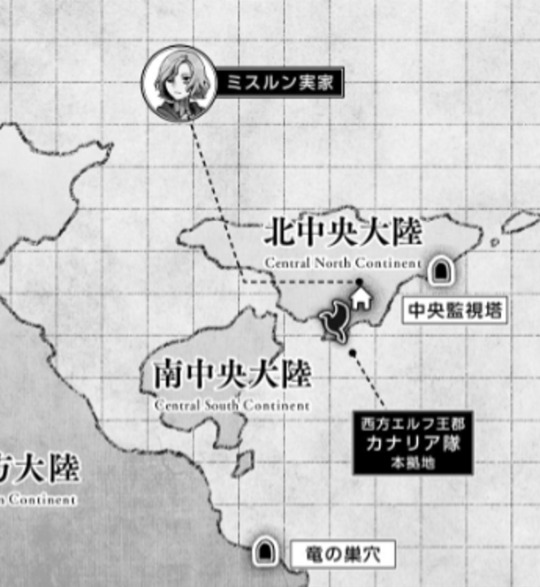
These nations are where all the elves in the story except Marcille and Thistle are from. This post collects all the information I could find about these two nations, and included a bit of analysis based on that information.
TL;DR (includes both fact and my speculation):
The Northern Central Continent is a feudal monarchy with a strong class system, as well as strict borders, & could probably be considered an ethnostate. It's deeply hierarchical, and the queen is a traditionalist - so it's probably very structurally biased against non-elves and half-elves.
Elves in the NCC practice cannibalism in some rural areas!
The Southern Central Continent is more diverse, with a large tallman population on its South Coast.
To elves, "Court Magicians" exclusively refer to those serving the elven queen - a prestigious role that seems likely to be only open to nobles.
The SCC may not be a monarchy, though it's not clear what kind of leadership or societal structure it does have.
The NCC will habitually take anyone involved in ancient magic as a criminal to prosecute on their terms, regardless of jurisdiction, but this depends on their political influence and ability to pressure local leaders to agree to extradite the criminal.
Elves VS Dwarves and Gnomes may have been at war around the time of the Golden Kingdom being sealed. This conflict also may be one of the factors pushing the kingdom to be sealed in the first place.
The "Central Region" might be the origin of the "Common Tongue" that our characters speak.
Northern Central Continent
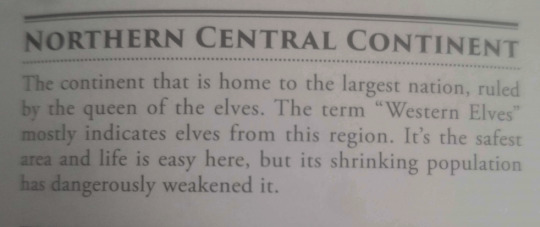
The Adventurer's Bible | p. 132
For this place to have a high quality of life, and also a declining population - especially when it's so close to the Western Continent, which is stated to have poor quality of life - there must be strictly maintained borders and a strong anti-immigration policy. Based on the attitude of the elves, I wouldn't be surprised if it was very difficult to move there unless you are also an elf.
It could probably be considered an ethnostate - and while in these kinds of fantasy worlds, that's pretty common. Take Rivendell, or Moria, in LOTR - they take for granted that these kinds of different fantasy races will live in separate communities.
But that isn't actually realistic, and I think Kui has considered it as more of a politically established status quo rather than an obvious natural result of having magically distinct "races". Which, even in Dunmeshi, I think is a difficult and not-terribly-accurate way to represent politics - racism does not emerge from actual, physical differences between races, after all.
But Dunmeshi's presentation of this idea is interesting, because of the recognition that if there is an "elven nation" which prioritises the interests and rights of elves over other races, that is because there's a deliberate, concerted effort to keep it that way.
But there's a small section of the NCC with a high tallman population - I wonder what kind of community they have, and how they fit into the strict elven hierarchy?
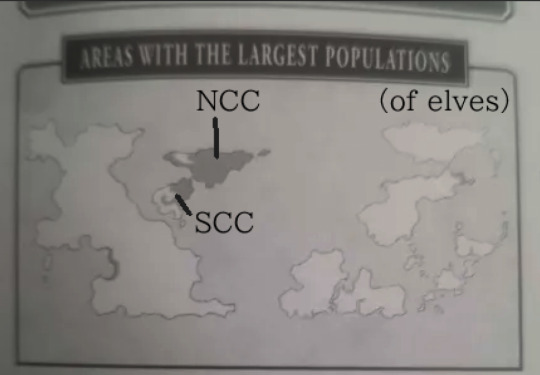

The Adventurer's Bible | pp. 134 & 136
Kabru and Rin, and other kids like them, who are adopted or taken as adopted children(rarely - the way Milsiril treats Kabru is not perfect, but she's deliberately attempting to be better than other elves.... meaning other elves are usually worse)/pets/objects by elven nobles, as well as accomplished or notable individuals who earn the elves' favour/are "invited" to stay (such as they try with Laios at the end of the story) would be an exception.
Other long-lived races could probably (...?) visit, but given the historical conflict between elves, dwarves, and gnomes, I think they'd also be pretty hostile to many of them coming to live on the NCC, even if they see them as more like equals.
Social Structure & Nobility
The Northern Central Continent is an absolute monarchy under a 372 year old queen, Heimeya (IDK what the official romanisation of her name will be).
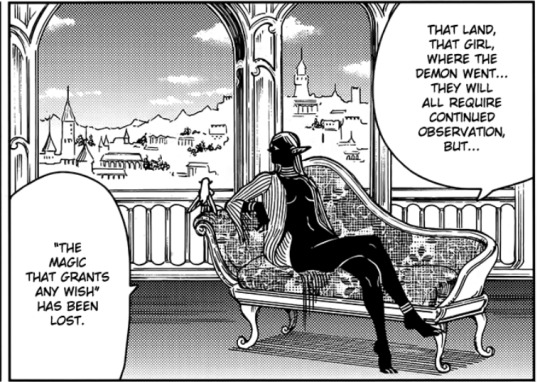
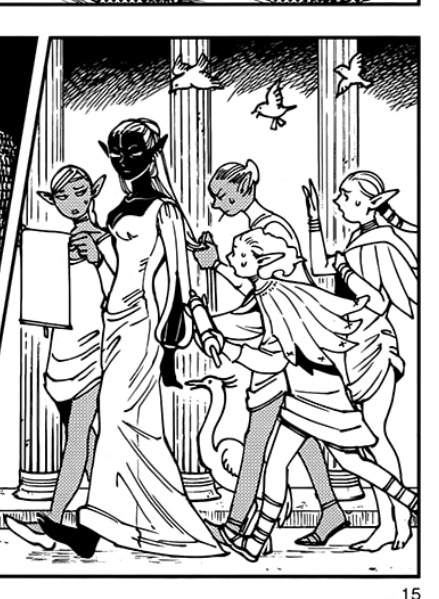
...With extended "nobility", which are the group that the canaries' guards draw from. We don't get much clarification of what sort of structure their nobility has, what titles there are, and where our characters who are nobles fall into it.
Pattadol (House of Vari), Mithrun (House of Kerensil), and Milsiril (House of Tol) are nobles.
Mithrun's noble house, Kerensil, is apparently a well-known family of investors! I wonder what sorts of businesses they invest in & what the elven economy is like?
Milsiril's house, on the other hand, is a well-known military family. I wonder if Kabru could claim the surname "of the House of Tol". He did go to family gatherings after all. But if he was comfortable doing so and it would be accepted, I would assume he'd have done so when introducing himself to the canaries.
Flamela is a distant relative of the queen, who has additional status due to exhibiting the genetic trait associated with their queens, extremely dark skin.
The queen is a "staunch traditionalist" who wouldn't even acknowledge a half-elf like Marcille. Nice! I really feel bad for Kabru and Rin growing up as tallmen in this sort of culture.
Court Magicians
While generally this is a term for any magic user who serves in a royal court, in the Northern Central Continent it seems to carry a lot of esteem; even just as the daughter of one, Pattadol assumes Marcille has the right to boss her around and to handle highly secret, highly illegal ancient magic secrets.
That makes sense, as in the society of the Northern Central Continent, you'd be directly serving the elven queen. But also, she has enough Court Magicians that Pattadol would not expect to know Marcille's mother's name, but few enough that it would be a big deal and Cithis would know about it if one had a half-elf child.
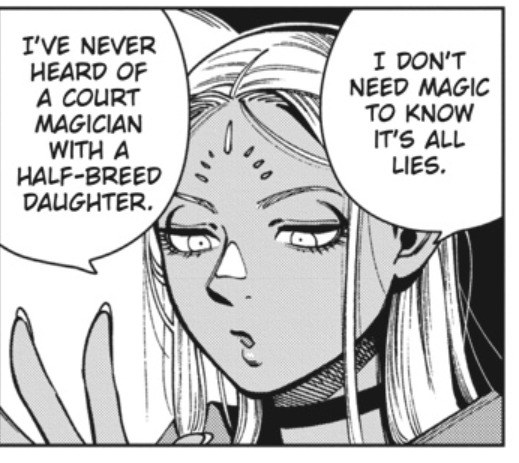
I don't think it's remotely unlikely based on that to assume that this role is only available to nobles.
A "Court Magician" who doesn't serve the NCC Queen isn't a "real" Court Magician in the eyes of NCC elves. Those short-lived monarchs would be happy just to have an elf around regardless of whether they were actually any good at magic.... according to Cithis.
Magic seems very important to the society of the NCC elves. The queen communicates with her subordinates via familar, and the birds we see surrounding her seem like they are some kind of magic - perhaps not familiars since we see her familiar, but some other kind of scrying?
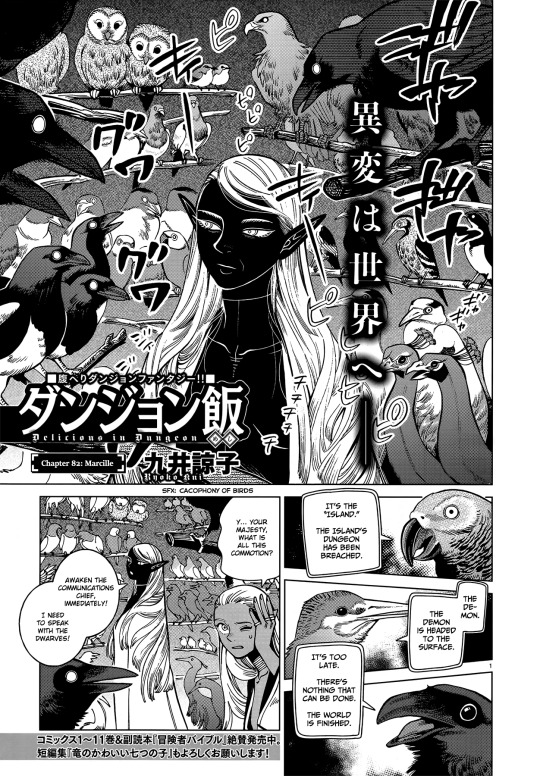
Also, based on the fact Pattadol assumes a Court Magician would be serving the Queen of the NCC, we can theorise that perhaps whatever structure the SCC has, it isn't a monarchy....? Heimeya is "the queen of the elves", after all - that doesn't sound like there's another elven monarch competing for the title just next door.
Ordinary People
Apparently the NCC is a safe place and life is easy -- but given the strict class system, I kind of expect that varies a lot depending on the family you're born into.
The only elves we meet who are not nobles are the convicted criminal canaries, so it's hard to get a sense of what life is like for them from that. Cithis was apparently a wealthy fortune teller with "an intense jealousy for those born noble or wealthy." So I assume she was not born into comfort.
Apparently "There are also primitive villages deep in the woods and underground, and in some regions cannibalism is still practiced." Which is awesome. Based on her videogame elves art I think Kui's probably making a little nod to Divinity: Original Sin elves, who can absorb memories through eating the flesh of others. Elves in dungeon meshi don't have this trait, but I wonder if there is a magical ritual or some kind of cultural practice with a similar intention.
Cuisine
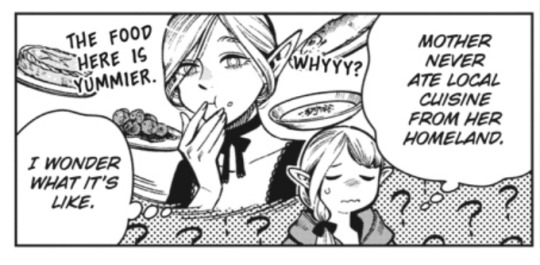
Marcille's mother didn't think much of the elven cuisine.
Liricmumwarel is fancy candy given out by the elven queen the shape of which conveys blessings.
Elf Cake is a crumbly dry cake that Kabru and Thistle don't think much of. I've heard someone discuss what it's likely to be made of, but I am afraid I don't recall.
Southern Central Continent

The Adventurer's Bible | p. 132
It seems like the Southern Central Continent gets a lot more immigration and has a more diverse population, especially along the south coast (near the Western Continent). That south coast has a high tallman population.
Fleki and Lycion are from the Southern Central Continent. Fleki got into ancient magic for the money, so you can assume there's probably class disparity there too; things are noted by Kui to be more "disorganised" than the NCC. Not a bad thing at all - the NCC is definitely too "organised" in my books. But that does potentially also mean there's less, e.g., bureaucracy, central organisation, less of a social safety net. But then again, in the NCC I doubt that whatever "safety net" there is, is available to everyone.
We can't extrapolate much from Fleki & Lycion's personalities, because they clearly aren't in the most stable societal position, and I get the sense that they're the countercultural type - they probably don't represent the type of person typical to the SCC. Also, our NCC characters are all either nobles or used to navigating high society (Cithis, Kabru to an extent) so they aren't exactly a typical "ordinary NCC person" as a basis for comparison either. However, there's less of a "strict set of social rules" type of feel to the SCC characters, fitting with my suggestion that the SCC may not be a society with a strong feudal element.
Geopolitics & Conflict
The fact that, despite their being from the SCC, Fleki and Lycion are in the Canaries, who work directly under the NCC's Queen, implies that the the NCC feel entitled to process and prosecute people who commit ancient magic-related crimes regardless of any notion of "jurisdiction". This is backed up by the way that they were going to take Marcille - but that is something that the governor of the Island had to give permission for, which Laios is able to withdraw. So I assume that the NCC elves apply pressure on various world leaders to extradite criminals involved in ancient magic.
The SCC would cooperate with this, since they're allies, even if they don't have a great relationship (according to the World Guide).
The NCC are also clearly able to take half-foots without trouble, as we see by Chilchuck saying he's known half-foots who got involved with "black magic" (ancient magic) and were disappeared by the elves. But I doubt gnomes or dwarves are giving people up easily - though that probably doesn't go for dwarves like Senshi and Namari, without strong community ties.
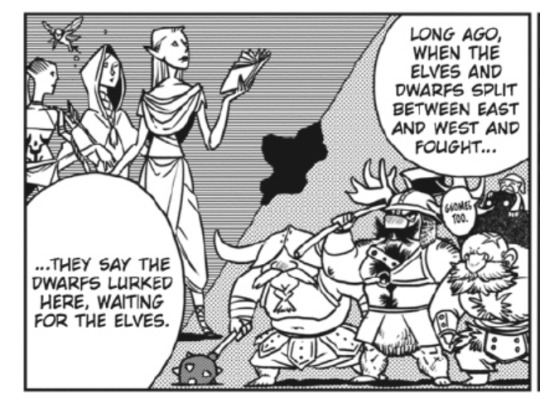
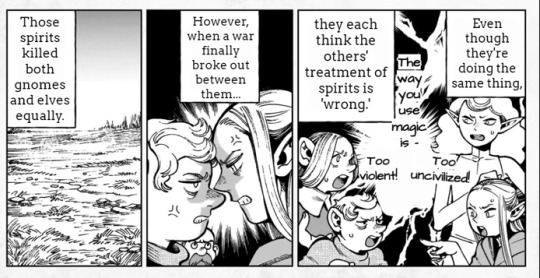
Long before the current times, elves fought dwarves & gnomes. There might have been more than one of these conflicts...? While long ago, this war isn't "ancient" (like the ancients who sealed the demon into dungeons, before their world was mostly destroyed by it).
Thistle, Delgal, and the Golden Kingdom were (I believe) caught up in one of these conflicts, which used Melini as a staging ground - thus why Thistle was pushed to seal the entire kingdom in the dungeon.
To do this, Thistle unseals a dungeon created by the "ancient people". These could be the "ancients" who created the dungeons, before the apocalypse. Or they could be another, still extinct, society.
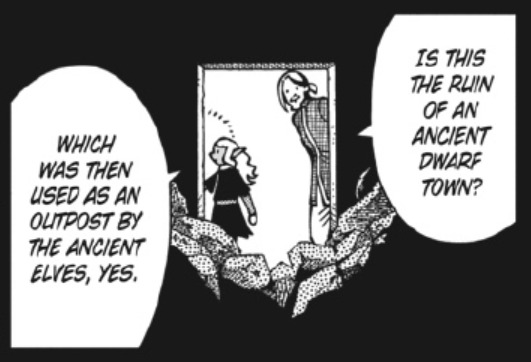
Regardless, at least one of these conflicts seems to have taken place after the golden kingdom was sealed - so, within the last 1000 years.

Though, this could refer to a different, more localised conflict between the Golden Kingdom and their dwarven neighbours.
The order of events is that the Golden Kingdom was sealed (1000 years ago or so) > Dwarves took over > Elves stole the land from the Dwarves ("long ago" by the Island Lord, a tallman's, standards) > Elves gave the land to a local lord, who was either an ancestor of the Island Lord, or the Island Lord himself. The Island Lord is himself a descendant of the lord who poisoned Delgal's father, as is noted in the World Guide. However, it isn't impossible for there to be large gaps of time between these events, which could put the elf / dwarf wars at a more recent date.
The fact we know that the elves stole the land from the dwarves, and then granted it to a political actor who was relevant during the events of the Golden Kingdom flashbacks we see suggests to me that the events were roughly contemporaneous. If they were, that puts at least one of these conflicts at roughly 1000 years ago.
So, the elf/dwarf & gnome conflict is "long ago" by short-lived standards, but would be considered "modern" by the long-lived races, if you ask me. At least, the equivalent of the World Wars for us - recent history, even if we weren't alive.
I'm guessing the "Elf King" from the below panel in fact was a word that's more gender-neutral in Japanese, since the "Western Elves" definitely have a queen.

Language
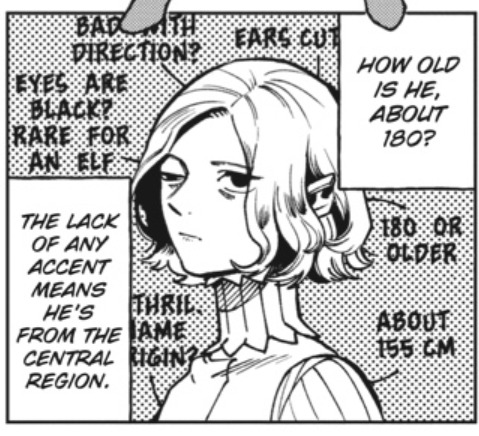
When Kabru says the "Central region" I expect he means the region where the NCC and SCC is.
The fact that he observes that the lack of any accent means he's from the Central Region is really interesting. It could mean two things;
either they switched to speaking in the language spoken on those continents, which Kabru would naturally know, having grown up there. It's 100 percent possible, but I think this would be noted in the story.
or, the language that gets called "the common tongue", the one that all our principle characters speak for most of the story, originated from the elves in the Central Continent. Or at least it's the same one that the elves use, and their political influence is great enough that their accent gets to be considered not an accent at all. The fact they were "granting" land in this area to tall-man lords suggests a large enough historical influence in the area that this is quite plausible to me.
Mithrun absolutely does have an accent - nobody speaks without an accent. His accent is just politically and socioculturally normalised to the point of being considered the "default/proper" way to speak - like received pronounciation in English.
The common tongue isn't ubiquitous everywhere - not just Kuro, but Kiki and Kaka are also noted to be studying the common tongue. The Tansus were born on the Eastern Continent, so probably gnome communities there speak their own language - Kiki and Kaka grew up primarily surrounded by gnomes after all.
It's also quite likely that Kabru, specifically, because of where he grew up, would consider Mithrun's way of talking to be the default "not an accent" accent. His adoptive mother surely has the same upper-class NCC accent. I expect that other characters might experience it as more "marked".
This isn't a world where everyone speaks the same language everywhere; the common tongue is called that, but there are many different languages. Kabru and Chilchuck are two characters who are adept with many of them - Kabru speaks the language of the kobold, and probably lots more. Chilchuck works as an interpreter as part of his union stuff - I can tell you from experience that that's a hugely valuable skillset in that context, as many of the people who most need union representation are people who don't speak the dominant language, or at least not fluently.
If you got all the way to the end of this post.... thank you for reading, I love you. Check out my other World Map Notes under that tag on my blog; I've made a few so far and there will almost certainly be more. Next I'm thinking the dwarven nations...? But I could be persuaded if someone had a preference.
Also, anyone got any speculation on what, exactly, is the previous time that Heimeya ate a person/monster/chimera that this panel implies:

We really don't have anything to go on whatsoever, but I think it's a fun tidbit.
#og post#dungeon meshi manga spoilers#dungeon meshi meta#dunmeshi#dungeon meshi analysis#delicious in dungeon spoilers#dunmeshi spoilers#delicious in dungeon#dunmeshi meta#the canaries#milsiril#mithrun#kabru of utaya#i feel sooooooo sane to have made this. but it has some super interesting details imo#colour coding only on the TLDR just cause I dont want ppl to take my theories as fact#character info I drop without a panel comes from the world bible#world map notes
148 notes
·
View notes
Text
The biggest Easter egg yet
I’ve been meaning to address this for a while now, but @camdenleisurepirates gave me the final push after reading my piece on Gabriel’s cross. Huge thanks for that morsel of motivation, my ADHD brain loves you.
This is going to be yet another long read, although not as extensive as my bookshop statues meta. Still, better get yourself some hot chocolate or another drink of your choice and make sure you’re comfortable!
Now, remember the X-Ray interview with Peter Anderson on Easter Eggs in the opening animation he created for the second season? Forget red herrings, apparently our fandom has a literal red phone box! I’m convinced that this whole scene is a one big — the biggest, actually — Easter Egg, and I’ll explain why step-by-step.
The red phone box Crowley used to warn Aziraphale about the Antichrist and the following Armageddon in S1, the exact one where he left change for an emergency call, seems important enough in terms of the future S3 plot, but there’s so much more going on in this frame. Not only the lift.
The angels
At the very start of this sequence we can see a fragment of an elaborate bridge guarded by cherubs sitting on two columns, maybe globes, leading to a distant structure built over a literal mountain of trash — all elements of the S1 and S2 openings which were consciously picked out by the animators and put together in a very ominous pile.
Ready for some scavenging?


In the Gabriel’s cross meta, I already mentioned the importance of Ponte Sant’Angelo in relation to the ex-Archangel’s statue. Now it’s time to widen our perspective and focus on the full picture — quite literally. Apparently the bridge from the opening sequence has ten statues of angels, exactly as the Italian historical monument.


First things first though: the two big cherubs guarding the entry to the bridge might seem familiar to some of you. While they’re obviously not copies of the same statue, a very similar pair of brass cherubs is placed in Aziraphale’s bookshop to symbolize Aziraphale and Crowley. And looking at the screenshot above and the way they sleep or sulk with their backs turned on each other, they are most certainly not talking. The addition of more than one set of eyes is a lovely reference to biblically accurate angel memes though.
If we assume the traditional left-right positioning of the characters, Aziraphale is on the left and Crowley is on the right. Directly behind Aziraphale we can see a ship named “Good Traits”, but in reverse — kinda sorta confirmed by the animator Peter Anderson to be connected to the concept of the seven deadly sins on Twitter. Same that was mentioned recently by Neil in one of his asks.

The presence of Gabriel — a renegade Archangel wielding a broken cross — on the right, Crowley’s side, seems to match this theory. It could also support one of the possible interpretations of the very last bookshop shot in the S2 finale.
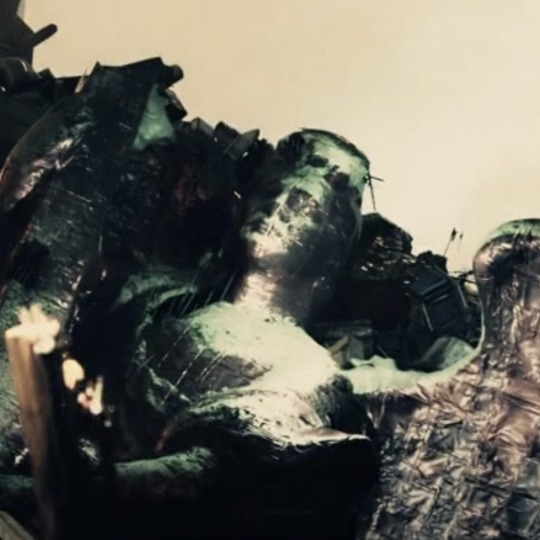
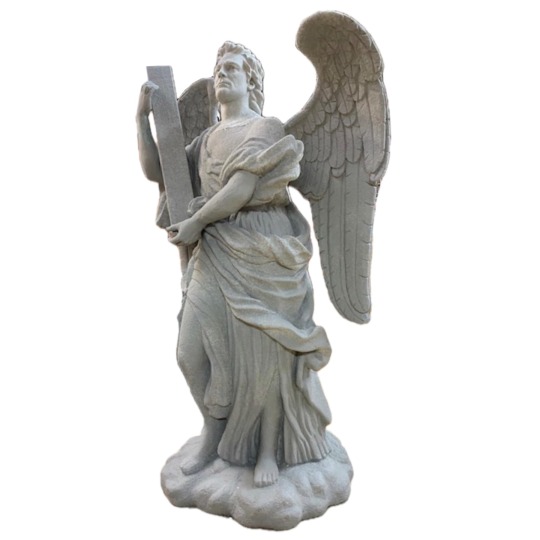
Out of all ten statues, Angel Carrying the Cross by Ercole Ferrata is considered inferior to the others on the bridge in that it appears to be a two-dimensional relief sculpture rather than an unbounded three-dimensional artwork, which seems to match Gabriel’s first impression as a character.
The inscription on the statue reads, “Dominion rests on his shoulders" — that is the weight of the cross that Christ was forced to carry through Jerusalem before being crucified. Even though Gabriel’s burden partially disappeared, the whole bridge and its environment is covered with crosses. It’s clear that we’re looking at a direct parallel of Via Crucis, the Way of Sorrows.
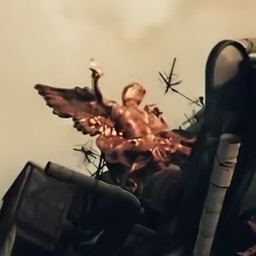
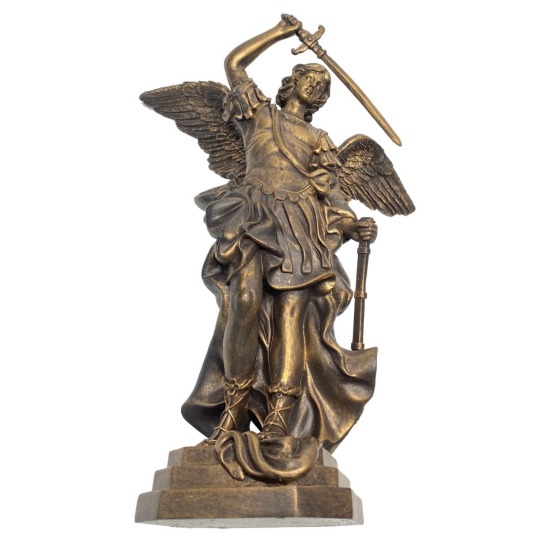
Towering over the Italian bridge, at the very top of Castel Sant’Angelo, is a statue of Archangel Michael, seen as the golden angel on the top left part of the trash pile. Aziraphale’s side, perhaps as his assistant, perhaps a rival? Legends of the Jews mention Michael as the chief of a band of angels who questioned God's decision to create man on Earth. The entire band of angels, except for Michael, was condemned to Fall — which could explain why they have such a good access to the Grapevine That Obviously Doesn’t Exist. And whatever’s going on between Michael and Dagon, perhaps.
In Roman Catholic teachings, Michael has four main roles or offices. Their first role is the leader of the Army of God and the leader of Heaven's forces in the final triumph over the powers of Hell. Viewed as the angelic model for the virtues of the spiritual warrior, their conflict with evil taken as the battle within. The second and third roles of Michael deal with death. Their second role is that of an angel of death, carrying the souls of Christians to Heaven. Michael descends at the hour of death and gives each soul the chance to redeem itself before passing; thus throwing the devil and his minions into consternation. In their third role, Michael weights souls on perfectly balanced scales they are often depicted with as their attribute. In their fourth role, Michael appears as the guardian of the Church. Might be the reason why they’re the closest to the building on top of the mountain.
It looks like Michael lost their sword though, just like Gabriel lost a part of the cross he was supposed to carry. The sword in question was supposed to be used to slay the dragon — Satan, the Adversary — according to John of Patmos and his Book of Revelations.
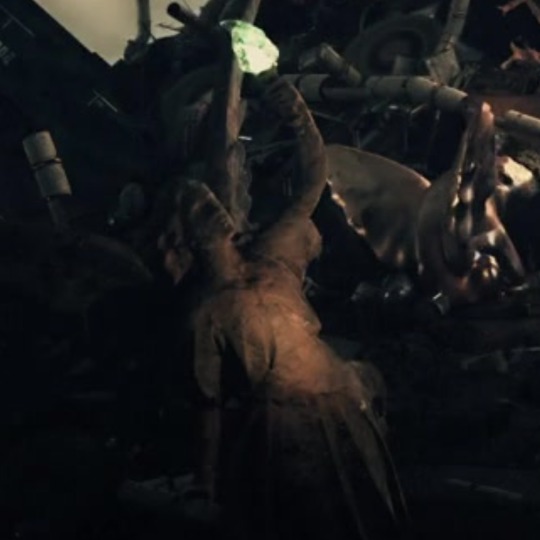
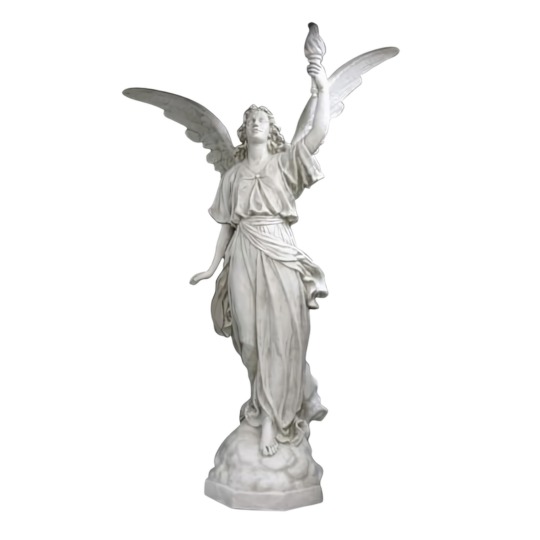
Speak of the devil: interestingly, there are two copies of an anonymous variation of the Angel of Light statue appearing twice on both sides of the bridge. Both the title as well as the statue itself seem like obvious references to one (former) angel literally called the Lightbringer, Lucifer. Perhaps one of them is representing his son, the Antichrist, instead, with the both of them helping out the Ineffables on two opposing — or perhaps only parallel — sides of the bridge?

The light carried by Lucifer appears to be green, a color used in the series as a visual representation of Hell, but on the intertextual level might also serve as a reference to F. Scott Fitzgerald’s classic novel The Great Gatsby and the green light at the end of the Daisy’s dock symbolizing the undying love, desperation, and longing for an unattainable dream. In the story, the color represents the limitations of power and money. Not surprisingly, the novel appears on Jim’s bookshelf and is part of the Good Omens book club — a list of personal recommendations from Neil Gaiman and Douglas Mackinnon for the fans to catch up on before the next series.

Last but not least, the possible connection to Libertas as the inspiration for the Statue of Liberty, shown multiple times in S2 as a foreshadowing of our character’s trip to America in S3. The related quote of Patrick Henry “Give me liberty or give me death” becomes even more relevant if we consider how the motto of the French Revolution was sometimes written as Liberté, égalité, fraternité ou la mort (“Liberty, equality, fraternity or death”). A lesson surely learnt by a certain angel back in 1793, when he was held prisoner for the last time before being forcefully taken Upstairs in the Final Fifteen.

The bridge and the castle
Okay, these are the basic observations. Now a brief historical overview and we will reach the fun bit in a jiffy.
Have you ever wondered about the meaning of this whole complex? It wasn’t always angelic, but named after a Roman noble dynasty. The Aelian bridge was built by the Emperor Hadrian in 134 AD to span River Tiber from the city center to his mausoleum. With time, the remains of more emperors were put to rest in there, until it was plundered and destroyed in a war. Then the remaining structure was transformed into a military fortress and a castle serving as the papal residence in times of war.

The Papal State also used Sant'Angelo as a prison; the Renaissance philosopher Giordano Bruno was imprisoned there for six years. Executions of the inmates were performed in the small inner courtyard, but they weren’t the only deaths in the area. On the other side of the bridge, in the adjoining Piazza del Ponte, under the watchful eyes of the stone likenesses of two saints, the public executions were held, and the heads of the criminals were brought onto the bridge and exposed to public view there.
As a prison, the former mausoleum is also the setting for the third act of Giacomo Puccini's 1900 opera Tosca. Long story short, the eponymous heroine convinces her lover to feign death so that they can flee together. Unfortunately, they are betrayed and the firing squad shoots at him with real bullets instead of blanks. Tosca believes in the quality of his acting performance rather than the truth, and when the realization hits her, she leaps to her death from the Castel’s ramparts.
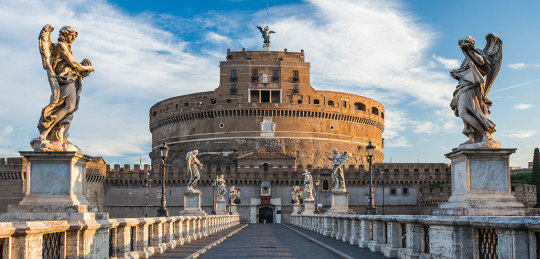
After Nero’s bridge was destroyed, the travelers were forced to cross this bridge as the only direct route to the Vatican and St Peter’s Basilica, earning it the nickname “the bridge of Saint Peter”. That’s why in the 16th century Pope Clement VII erected statues of Saints Peter and Paul at the ends of the bridge, guarding it as they are supposed to protect the entry to Heaven.
In 1688 the bridge was embellished with ten angel statues, five on each side of the bridge, carrying Arma Christi, the Instruments of the Passion. The Good Omens characters represented by those statues in the opening sequence might be other instruments of Christ’s suffering as parts of the system that needs to be overthrown or replaced.
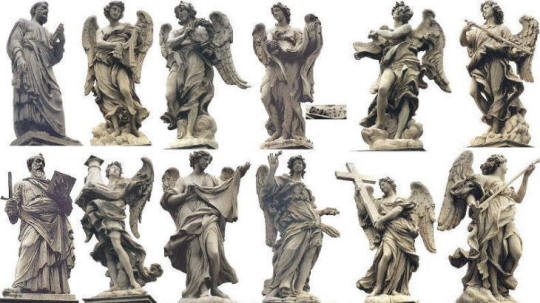
One angel appears particularly important in the context of both the bridge and the Second Coming — Saint Michael the Archangel.
Legend holds that the Archangel Michael appeared atop Hadrian’s mausoleum, sheathing their sword as a sign of the end of the plague of 590, thus lending the castle its present name. A less charitable yet more apt elaboration of the legend, given the militant disposition of this particular Archangel, was heard by the 15th-century traveler who saw an angel statue on the castle roof. He recounts that during a prolonged season of the plague, Pope Gregory I heard that the populace, even Christians, had begun revering a pagan idol at the church of Santa Agata in Suburra. A vision urged the Pope to lead a procession to the church. Upon arriving, the idol miraculously fell apart with a clap of thunder. Returning to St Peter's by the Aelian Bridge, the Pope had another vision of an angel atop the castle, wiping the blood from his sword on his mantle, and then sheathing it. While the Pope interpreted this as a sign that God was appeased, this did not prevent Gregory from destroying more sites of pagan worship in Rome. In honor of the vision and Michael, the bridge was renamed in their name.

What if the procession from the opening sequence was meant to imitate the procession led by the Pope from the legend? What if Aziraphale, now officially a Supreme Archangel, Commander of the Heavenly Host, is the one actually leading it, with Crowley finally at his side as his partner and second in command, just like it was proposed by him in the Final Fifteen?*
What if by some reason, maybe personal ambition, maybe just a tragic coincidence or situational necessity, there really was an impostor in Heaven, and Metatron — the so called Voice of God who seemingly doesn’t speak up for Herself since Job’s test — has been playing a winged version of the Wizard of Oz all along?
It would make just the perfect sense if not for one tiny detail. The procession we see on the bridge is actually led by Crowley, which doesn’t fit the parallel at all — unless it’s actually a proof of an ongoing body swap, as the mismatched names of the actors could also suggest?
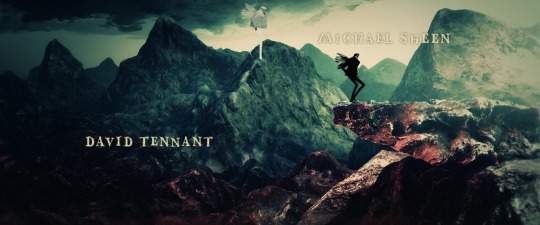
The mountain of trash and the bookshop
The symbolic mountain of trash we can see Aziraphale and Crowley climb is a reference in itself. To an actual mount called Zion, believed to be the place where Yahweh, the God of Israel, dwells (Isaiah 8:18; Psalm 74:2), the place where God is king (Isaiah 24:23) and where God has installed king David on his throne (Psalm 2:6).

In a literal sense, it’s a hill in Jerusalem, although the sources refer to three different locations in different contexts — although for the purpose of this meta the Upper Eastern Hill (Temple Mount) makes the most sense. Its highest part became the site of Solomon's Temple. The same King Solomon the rituals in Freemasonry refer to. Masonic buildings, where lodges and their members meet, are sometimes called "temples" specifically as an allegoric reference to King Solomon's Temple, not actual places of worship. And Aziraphale’s bookshop is built around Solomon’s Magic Circle.
In a metaphysical sense, and especially in the context of the Christian New Testament, it is also believed to be a part of Heaven — the heavenly Jerusalem, God's Holy, eternal city. Christians are said to have “(…) come to Mount Zion and to the city of the living God, the heavenly Jerusalem, to an innumerable company of angels, to the general assembly and church of the firstborn who are registered in heaven” (Hebrews 12:22-23 cf. Revelation 14:1). Just like the procession were following in the opening sequence.

There’s been some speculation whether the lift on top of the mountain could symbolize Aziraphale’s bookshop, or, more specifically, the oculus in its centre. If you look closely at the enhanced screenshot, you can see that the dome isn’t made of glass and that it looks like a tower (a church’s bell tower, perhaps) more than a whole building.
And there is an actual doorway in there — not like the modern lift doors — opening up towards the source of that white, heavenly light. And what kind of enlightenment can you usually find up in the skies or heavens?

We’re welcomed to crack open the doors to the Heavenly Sanctuary — the Most Holy place, Sanctum Sanctorum, the Holy of Holies — to undraw the final curtain and finally stand eye to eye with God. Who knows, maybe even ask some questions or listen to some answers.
Or, at the very least, to meet one of Her forms known as Jesus Christ. Because that’s precisely where he serves as our (humanity’s) Mediator and the Holy Priest after his Ascension to Heaven. The structure at the top reminds of some temple architecture seen in Antiquity and Christianity.
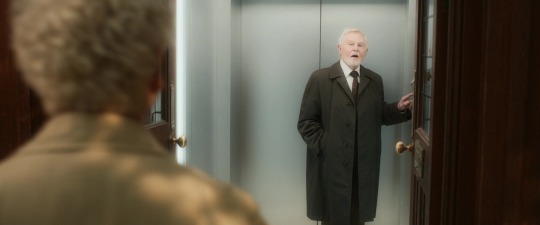
The Catholic Church considers the Church tabernacle or its location (traditionally at the rear of the sanctuary) as the symbolic equivalent of the Holy of Holies, due to the storage of consecrated hosts in that vessel and their meaning as the Body of Christ. Tabernacle is commonly marked with a red light turned on and off depending on His presence or lack if it.
Looks like He’s already in the area, one way or another, keeping eye on some things.
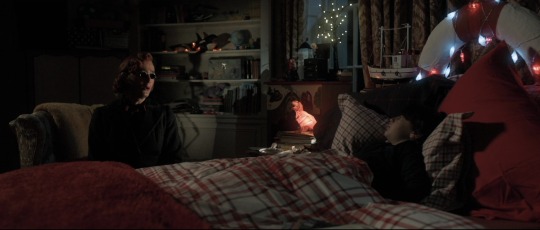

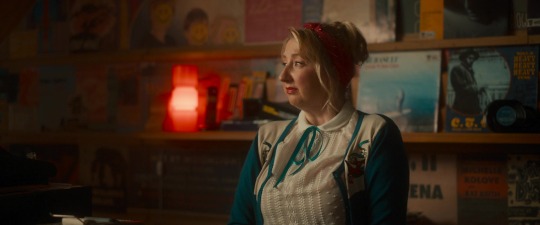

Are we following a procession of believers happy to embrace their one and true Savior? Or are they actually protesters on their way to dethrone the authority and the system?
Guess we will have to wait and see.
#the good omens crew is unhinged#everything has a meaning#title sequence#angels everywhere#archangel fucking gabriel#gabriel’s statue#bookshop statues#statues update#ponte sant’angelo#let there be light#good omens analysis#good omens meta#bible fanfiction#yuri is doing her thing
119 notes
·
View notes
Text
The Teeth of God is such an interesting phrase to choose to me.
We have mouth of God, which innitates the idea of prophets; speaking God's words to Their followers. Then, we have hand of God, which is something utterly violent but done for the 'greater good' of humanity. Finally, we have eyes of God; omnipresent, imminent God who sees all and judges all with a mighty eye.
But Sleep Token, out of all the commonly chosen phrases, chose teeth. Ganshing, biting teeth that break and destroy. Sharp canines that, at least in the Bible, refrence the final judgement of sinners and their reaction to their punishment.
Just a thought.
#here I come finding religion in Sleep Token again#we always here about 'the mouth of God' and 'hand of God' but never once have I heard 'Teeth of God' outside the Bible#(I know a truamatised Catholic/C of E kid when I see one)#it also works incredibly well with Sleep Token's whole biting/consumption/eating thing#'I don't know what's got it's teeth in me but I'm about to bite back in anger' GET EM' VESSEL#sleep token#st#mel's rambles#sleep token analysis#teeth of god tour
77 notes
·
View notes
Text
My complete and unhinged Metatron analysis
Hello, I have seen that many people are theorizing about Metatron, so I'm here presenting an analysis of who Metatron is, rather his biblical role and how he may be more connected to the Aziraphale and Crowley than we might believe.
-Also, English is not my first language, so please be patient with me-
ANALYSIS OF METATRON AS A FIGURE WITHIN CHRISTIANITY:
Metatron, has always been a controversial figure in Christianity, full of dualisms.
Let's start with its etymologically. The term Metatron has two completely different translations: one comes from the Greek metradromos meaning "he who pursues with vengeance"; or it is also possible that its origin is from the term meta ton thronon which means "closer to the throne". There are many doubts about his true origin, since it is mentioned in non-canonical versions of the Bible, during Genesis*. However, in the most current and official versions of the Bible, it never appears.
While there is nothing official, the most accepted version is that he is actually the prophet Enoch, Noah's grandfather. Enoch -who used to have his own book of the Bible in earlier versions- was a prophet who had the God-given gift of visiting Heaven through different visions. In his 1st vision, Enoch has the mission to intercede with God on behalf of the fallen angels. In another vision, he sees the Cherubim in Heaven, whom he describes as beings of fire. Later, he is taken by the archangel Michael to the highest heaven. Enoch also travels in his visions or dreams to the tree of knowledge. He is supposed to have lived 365 years and, at the end of his visions, Enoch is chosen by God to become the archangel Metatron, a powerful archangel who is also called the little Yahweh.
There is another explanation for his origin: he is the first being of creation, seated at the left hand of the father, which in tradition is associated with Satan.
The Zohar also describes Metatron as "the king of angels" who reigns over the tree of the knowledge of good and evil.
When Enoch was on Earth, he devoted himself to writing a book containing the secrets of wisdom until he was taken to Heaven to become an angel. God allowed Enoch to continue this same ministry in Heaven** .

FUN FACTS:
Metatron was the one who led the Israelites to the Promised Land (Moses).
Metatron is the patron angel of children.
Metatron transmits God's daily orders to the angels Gabriel and Raphael.
Not being an angel from his origin, Metatron is associated with the angels in charge of Death, he supervises them when they help the souls to make their transition from the physical to the spiritual plane.
He is canonically the most powerful archangel in the entire celestial realm, second only to God. His role is similar to Lucifer's original rol, the right hand of God.
The archangel Metatron is in charge of directing the ascension and activation of the human being's light body. Having been human, he knows the path of enlightenment. He represents the potential for transformation and purification of the soul when it sets out to transcend matter to unite with the pure spirit of the Divine. Metatron is in charge of guiding the souls towards the light, towards purity (insert the fact that he asks for coffee with almonds, which in Christianity is related to purification).

METATRON IN THE LORE OF GOOD OMENS
It is worth mentioning that in the original Good Omens book, Metatron is the only angel that appears besides Aziraphale. While other angels are mentioned, Metatron is the only one who appears, firstly when Zira wants to talk to God, and secondly when Beelzebub and Metatron make presence at the Tadfield airbase to try to convince Adam to restart the end of the world (it is not Gabriel who appears in the book).
And, considering that the 3rd season is based on the sequel to the book that never came out, it makes sense that Metatron would have had a bigger role because he was always a present character.
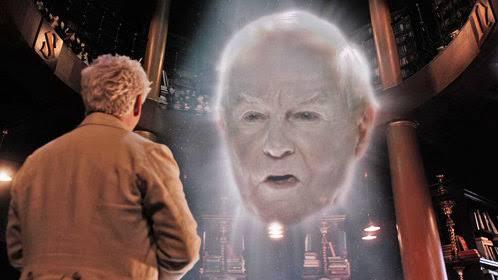
HIS RELATIONSHIP WITH CROWLEY AND ZIRA:
So, from all this information, I would like to point out that Metatron not only used to be human and knows the "true path of purification," but he is also in charge of caring the tree of knowledge.
You know, that tree?

Aziraphale and Crowley represent the two things that oppose his very existence: an angel that is becoming more and more human with each passing day and the Serpent of Temptation that keeps doubting and questioning the edges and the difference between good and evil.
These two not only were they not punished, but together they are two extremely powerful entities, perhaps as powerful as he is.
They are a threat… but only together.

Metatron can see in Aziraphale the very opposite of what he represents, someone who needs to return to the path of divinity:
Aziraphale, the supposed guardian of Eden, who started out as an angel, who gradually transformed into someone with more and more human habits, falling into almost all the deadly sins, in love with the Serpent who tempted humans to eat from the forbidden fruit of the tree of knowledge. Someone who loves forbidden books and bibles, with a hedonistic and condescending personality who managed to deceive his brother angels for millennia to protect humanity and his earthly life***.

It would also explain his disdain towards Crowley, why he looked at him with that face: Metatron is the protector of the tree that Crowley managed to corrupt.

To all this we can add that Metatron/Enoch renounced his humanity to become something superior, while Crowley and Aziraphale consider humanity to be something superior worth defending and loving. They see in humans what Enoch could not see behind his judgment of false celestial purity. They are two supernatural entities who managed to love humanity more than he, a human, ever could.
These parallels are not only born out of my obsession, no. The fact that Metatron has separated them has a much more possible and deep significance.
Narratively, this can only mean one thing: Metatron is the villain, the perfect antagonist to Aziracrow.

CLARIFICATIONS
*Genesis is where the Adam and Eve story is found, the Garden of Eden, the moment that changes Zira and Crowley forever….
**That "book that contained the secrets of wisdom"… is it the book of life? Is Metatron the only one who has access to it?
***I would like to clarify, that for me the real main character of Good Omens is Aziraphale, that's why I find more comparisons with him, followed by Crowley as co-protagonist, but I will continue this theory another day.
#good omens#ineffable husbands#aziracrow#did i just also make a whole bible analysis? Look what you made me do gaiman#can this be tagged as a bible study?#bible study#every time i see a catholic metatron figure i want to throw up#neil gaiman#terry pratchett#good omen season 2#good omens theory#good omens metatron#go2#aziraphale#crowley#good omen 2 spoilers
154 notes
·
View notes
Text
Surrender the angle
Let's about a talk about "SURRENDER THE ANGLE", okay?!? Do I enjoy writing meta that comes across as bonkers? Yes. Yes, I do!
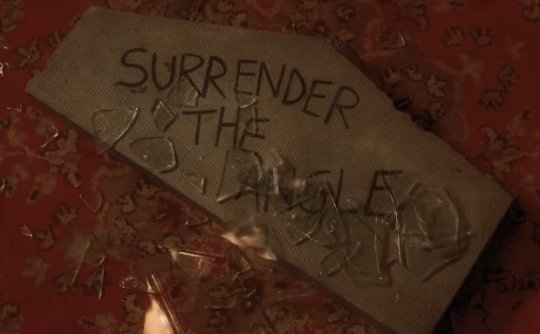
I can't help but wonder about this (and we all know Neil Gaiman is a fan of double meanings).
It doesn't say "Surrender Gabriel", and it makes me think of this scene from The Wizard of Oz in which the Wicked Witch of the West is making it perfectly clear what she wants from the merry old Land of Oz (which is strikingly similar in sound of the Land of Uz, which I don't think is an accident, but that's not for this post).
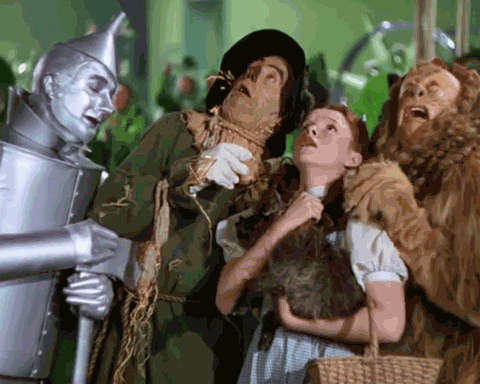
There are two angels in the bookshop, Jimbriel and Aziraphale, and a third angel standing outside just taking notes while the demons hassle Aziraphale, Crowley, Gabriel and all the humans.
Aziraphale actually helps Gabriel and Beelzebub escape, which goes against what Heaven and Hell both wanted to do to them.
And then Aziraphale goes back to Heaven after a chinwag with The Metatron.
And I'm sure many people would like to disagree with me because Aziraphale is easy to scapegoat as the bad guy by many people in this fandom, but we did not see the entire conversation between Aziraphale and the Metatron.
"Surrender the angle" assuming that angle is simply a misspelling of "angel".

Again, Aziraphale plainly stated that he did not want to go back to Heaven. I don't think he agreed to go back because he thought it was a good idea.
I think he fucking surrendered himself to Heaven. I've touched on this briefly in this post about Aziraphale's conversation with The Metatron and this semi-crack post about the portal to Heaven in the bookshop.
But there is also another angle (see what I did there?) to consider!!
Because looky-looky here!!

Not only is angle used in the Bible, but takes us back to A Companion to Owls!

Lo and behold, this verse from Job is about the Leviathan!!
The Second Coming has already been set in motion (remember the zombies Furfur unleashed on Earth and "the dead shall leave their graves and walk the Earth once more").
Remember Shax looking for demons who are doing good deeds?
Remember that Crowley was pulled into Hell in Edinburgh after doing a good deed in the presence of Gabriel's statue, which furthers the idea that Aziraphale and Crowley are never not being watched (see my post about Goldstone's)?
Remember when Michael found evidence of Aziraphale and Crowley working together in season one and presented it to Gabriel?
Am I making sense to y'all? Do you understand what I'm putting down here?
Which leads me to wonder...
Are Aziraphale and Crowley "not talking" because of the fact that they've been caught and have to play it safe? They have to communicate through other means? Which is what has lead me to my thoughts about Saraqael and why I can see Crowley becoming a Duke of Hell.
What's the angle of it all???
#good omens#good omens meta#good omens analysis#aziraphale#crowley#furfur good omens#good omens gabriel#shax good omens#muriel good omens#supreme archangel aziraphale#duke of hell crowley#the metatron#bible verses are important in good omens 2#aziraphale defense squad
82 notes
·
View notes
Text
A Biblical Warning Against Covering Up Injustice: Proverbs 24:24
I recently looked up some Bible verses about obstructing justice, and I found this one from Proverbs:
“Whoever says to the guilty, ‘You are innocent,’ will be cursed by peoples and denounced by nations.”
Proverbs 24:24
It’s so blunt and to the point. I love it!
After all, isn’t it a reasonable and perfectly human reaction to get disgusted when we see injustice being condoned?
Justice!
One of…

View On WordPress
#2 Samuel 12#Bible analysis#Frollo#injustice#Judge Claude Frollo#King David#Nathan#Nathan the Prophet#Proverbs#Proverbs 24:24#The Hunchback of Notre Dame
1 note
·
View note
Text
a friend was telling me about a time they were feeling unappreciated and i almost for real replied with "do not cast your pearls before swine." why tf am i pulling out bible quotes in casual conversation. this is what researching tlt meta does to a mfer
#it's bc i was elbows deep in bible gateway for a post in my drafts about ianthe's arm#it's not really a meta post i'm not doing any analysis. researching tlt references i guess#nonasbirthday
78 notes
·
View notes
Text
I read somewhere that people are so starved of content after that season 2 ending that they are just straight up purchasing the bible.
Well...so did I...

#good omens#angel crowley#crowly x aziraphale#good omens spoliers#ineffable spouses#crowley#good ineffable omens#aziraphale#good omens analysis#good omens season 2#thank you neil gaiman#we are all nerds and i love it#neil gaiman#terry pratchett#books & libraries#bible#ineffable bureaucracy#ineffable idiots#ineffable partners#the ineffable husbands#ineffable husbands
120 notes
·
View notes
Note
wait what were the bible references in ninjago. i caught the iron sharpens iron one but there were more??
ok well not really references but more so connections and parallels (intentional or not)
so obviously the one everyone’s brain jumps to would probably be lloyd and jesus and like,, yes because you know;
prophesied savior of the world, to destroy the hold evil had over humanity, arrives as a powerless child instead of a mighty conqueror, (grand)son of god
you get my point
but you know who really has more interesting parallels with jesus’s death?? garmadon.
he is, after all, actually the son of god in ninjago
oh and btw this is like where the idea that this is more me doing a literary analysis on this instead of saying these are direct parallels to one specific part of the Bible.
so let’s start with the idea of snakes. there’s a lot of them in ninjago and in the Bible, generally meant to symbolize evil in both contexts.
one snake in particular has extra significance, the great devourer, which parallels the serpent (satan) in the garden of eden. both are kind of this, embodiment of evil that find their way into a peaceful, early in time, garden or general sanctuary where humanity is still good. so in ninjago terms this would be the beginning of wu and garmadon’s lives before garm gets bit and turned evil. there’s also this interesting connection between the action of biting (eve with the fruit of knowledge of good and evil, which brought sin into the world, and garmadon being the one to get bit and this brings evil into the creation of god (fsm). but anyways now we have our tainted humanity and this conflict between good and evil in a way.
then we skip to the scene where garmadon and lloyd fight in ‘the final battle’ and you get this weird double parallels of jesus in both garmadon AND lloyd.
garmadon, the son of god, gets all the evil in the world placed into him, and he is publicly killed for it (i know he didn’t actually die but yeah it like cleansed him so same point still stands), when really he didn’t do anything wrong. he was bit by accident, almost the universe’s sacrifice. (jesuscore lol ok but actually think the crucifixion)
but you also have lloyd, who is the savior, who is the one doing the cleansing of evil, he is the light
dialogue parallels here:
overlord: “Where there is light, there will always be shadow”
lloyd: “Unless my light is bright enough!"
//
john 1:15
“The light shines in the darkness, and the darkness has not overcome it.”
not to mention garmadon’s name is the word Armageddon just mixed up so there’s that


oh and this was definitely intentional
#ciftr gets ninjago fans to read bible verses was not on anyone’s 2023 bingo#ninjago#lego ninjago#ciftrchats#ninjago lloyd#lloyd ninjago#christianity#literary analysis#media analysis#ninjago theory#ninjago garmadon#garmadon ninjago#ninjago season 1#ninjago lore#ninjago season 2
99 notes
·
View notes
Text
The Small Back Room — Hour of Glory (1949)
Good Omens 2 begins with the visit to The Small Back Room not because it was meant to serve as an exposition scene for Maggie and her record shop. It’s a substantial foreshadowing of the main plot and the relationship changes between Aziraphale and Crowley.
As all the other classics referenced throughout the show, this 1949 Powell and Pressburger production is easily available online — whenever you have 100 minutes to spare, I highly encourage you to watch it.
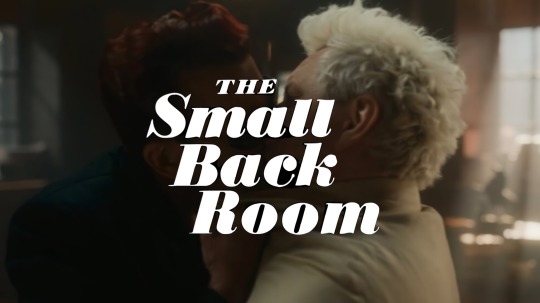
Our story begins with the arrival of Stuart, a British military captain, who makes his way through a labyrinth of offices towards a small building — the research section led by an eccentric, queer-coded, bow tie wearing professor Mair — to ask for help with a secret Nazi weapon.
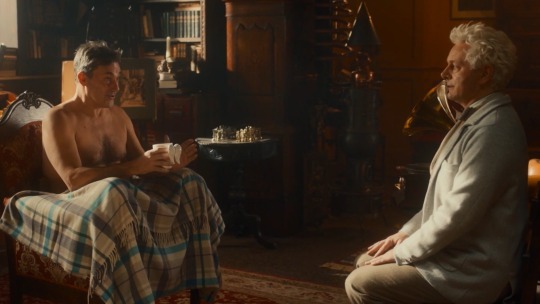
That’s when the professor calls our hero, Sammy Rice — an engineer and bomb disposal expert in the service of Her Majesty’s government and, not accidentally, the most brooding, wounded man in Powell and Pressburger’s impressive canon of dysfunctional and alienated characters.
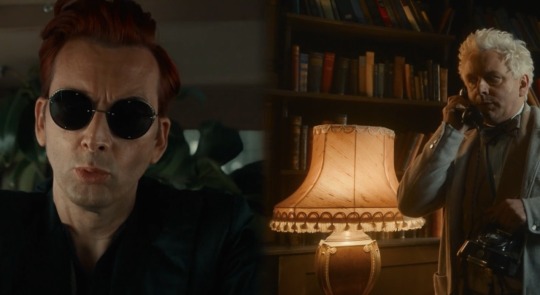
Due to a prosthetic foot keeping him from active service and confining to work in the titular back room instead, Rice is dramatically slipping into alcoholism. Haunted by self-loathing and disappointment with the internal politics, he can’t see the point of his research anymore.

Sammy is also conducting a clandestine affair with the secretary of his research unit, Susan. They live in the same building and meet regularly, but can’t openly enjoy their company or even dance due to his injury, which makes him even more bitter and pathologically determined to wear her angelic patience down.
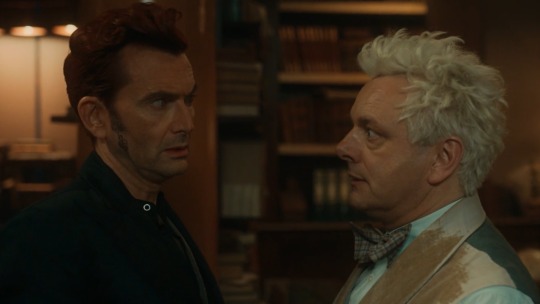
Susan puts up with it until the minister is forced to resign. She knows that if non-scientists take over, their section will become useless, Rice even more difficult, and the war possibly lost. She urges him to take action and when he dramatically refuses to make a difference, she leaves him.
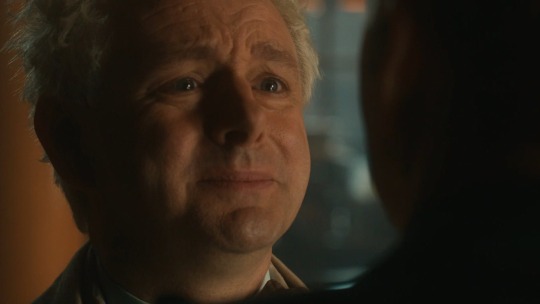
Seemingly at his lowest now, Rice becomes a sudden chance to redeem himself. Captain Stuart calls him about two unexploded booby traps found in Wales, but left to himself, he dies during a heroic attempt to dismantle one of the thermos-like devices before our engineer arrives at the scene.

In a nerve-jangling finale, Stuart’s notes help Rice dismantle the second device. He becomes a hero, gets an officer commission as head of the new scientific unit, and discovers that Susan not only came back in the meantime, but repaired everything he drunkenly destroyed in the apartment after their breakup.
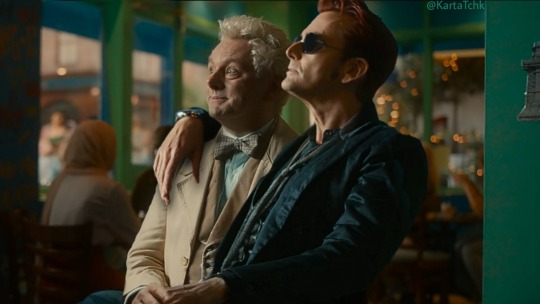
The parallels seem straightforward enough for me to add that in this context the role of Maggie through most of S2 may particularly reflect Crowley’s stagnancy in both work and love life. And if you’re unsure why the demon identifies with the heroic roles and characters, you might want to read this post on the subject.

Now, The Small Back Room was distributed in the US under another title — Hour of Glory. Which happens to be a specific Bible term referring to Christ’s “hour”, the period supposed to consummate all of his work on Earth and reveal God’s ultimate plan of salvation: the Son’s death.
John 12:20-36 Jesus replied, “The hour has come for the Son of Man to be glorified. Very truly I tell you, unless a kernel of wheat falls to the ground and dies, it remains only a single seed. But if it dies, it produces many seeds. Anyone who loves their life will lose it, while anyone who hates their life in this world will keep it for eternal life. Whoever serves me must follow me; and where I am, my servant also will be. My Father will honor the one who serves me. Now my soul is troubled, and what shall I say? ‘Father, save me from this hour’? No, it was for this very reason I came to this hour. Father, glorify your name.” Then a voice came from heaven, “I have glorified it, and will glorify it again.” The crowd that was there and heard it said it had thundered; others said an angel had spoken to him. Jesus said, “This voice was for your benefit, not mine. Now is the time for judgment on this world; now the prince of this world will be driven out. And I, when I am lifted up from the earth, will draw all people to myself.”

Christ’s hour began in the garden — this time the garden of Gethsemane — as he prayed passionately for the cup to be passed from him, similarly to Aziraphale declining Metatron’s offers on screen, both regarding the hot drink and his reinstatement as part of the Heavenly Host:
Luke 22:42 “Father, if you are willing, please take this cup of suffering away from me. Yet I want your will to be done, not mine.”
All throughout the Old Testament, we see God’s wrath being described as a cup poured out on sin and those guilty of it. By accepting it, Jesus took the toll of all the sins — from Eden up until the last one to be committed right before his Second Coming — on himself, for the sake of his beloved humanity.
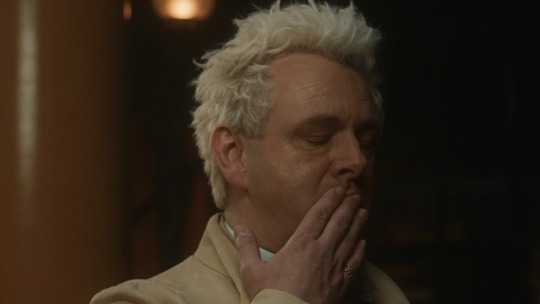
The passion of Christ continued as Judas betrayed him with a kiss, his disciples abandoned him, and the high priest accused him of crimes he was not guilty of. Even Pilate, the prefect of Rome, pretended to uphold the law; and remember we already expect a S3 trial based on another Archers movie.
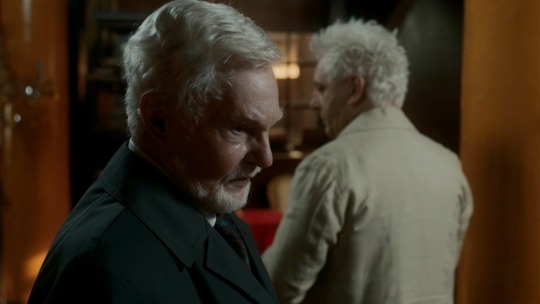
All in all, it’s an hour of great injustice and pain, but also glory of God. We’re led to believe that the Ineffable Plan will similarly triumph over the great one (or whatever Metatron tries to implement at the moment), as it did in S1. And its ending will be a good one, back in a garden.
#bible fanfiction#actually quoting bible#cup of suffering#give me coffee or give me death#the small back room#hour of glory#good omens#good omens meta#good omens analysis#final fifteen#crowley#crowley is a superhero#aziraphale#supreme archangel aziraphale#ineffable husbands#yuri is doing her thing#drinking coffee#an oat milk latte with a dash of almond syrup
60 notes
·
View notes
Text
my dash rn is insane
#post 1: merry crisis#post 2: JESUS VS MOSES SHOWDOWN#post 3: these characters fuck#post 4: JESUS VS MOSES SHOWDOWN#post 5: femboy moses or something??????#post 6: really deep analysis of the bible#post 7: these characters fuck NASTY#post 8: merry crisis
34 notes
·
View notes